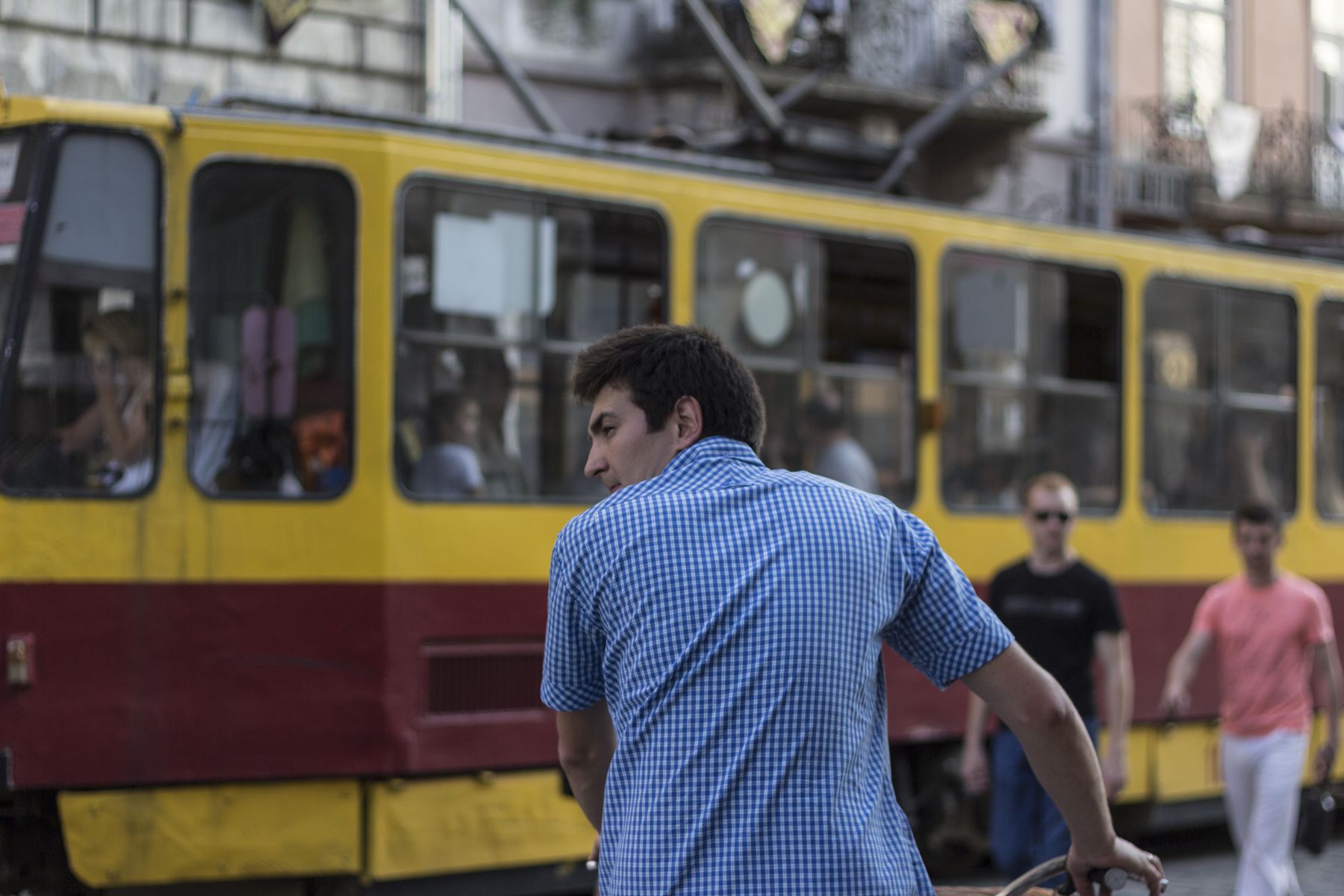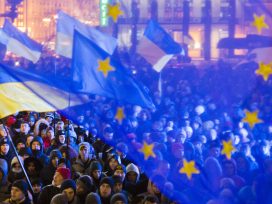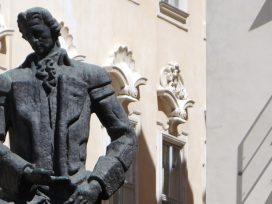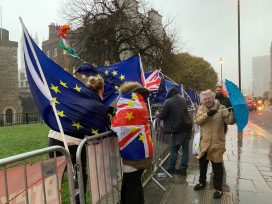Ukraine vs. Ukrainians: Different ideas of Europe
Ukrainian officials are trying to attract European investors to their country by stressing its low cost base and well-qualified workers. But as Artem Gergun notes, millions of Ukrainian citizens have grasped that these advantages are portable – and, rather than waiting for Europe to come them, are heading there for themselves.
Is the glass half empty or half full? This proverbial phrase is often used to indicate the progress Ukraine has made on the path towards Europe so far. Depending on the degree of criticism, western experts and journalists try to answer the question with cautiously optimistic or pessimistic answers. As a result the general picture is somewhat vague. Those who are more optimistic stress political freedoms, democratic competition, civic activism and pro-western foreign policy. Those who focus on the gruesome side tend to depict a dystopian landscape: oligarchs, poverty, corruption, the rise of far-right nationalism and backwardness.
There might be no better response to the ‘half empty or half full?’ question than to demonstrate that the situation may be seen in different ways (depending on one’s point of view) and that there may be opportunity as well as trouble. However, if we are to avoid an unnecessary psychological bias, we should follow Aristotle, who claimed that ‘a thing’s form is its essence’ (De Anima, 403a5). Thus, the water doesn’t matter per se, if it is leaking through cracks in the glass. The problem is the glass, not the amount of water in it.
Elites at a flea market
On 22 January 2018 the privately-funded Ukraine House in Davos officially opened its doors for guests during the 47th World Economic Forum. Its one-week programme, with the theme ‘Ukraine: Creativity, Innovation, Opportunity’, was supported by a number of leaders from business, politics and civil society, as well as President Petro Poroshenko. The key goal of the programme was to showcase Ukraine’s investment potential to investors, who were visiting the WEF.
Judging from the statements made at Ukraine House in Davos, participants considered Ukraine to have three major competitive advantages: low costs, a cheap but well-educated workforce, and booming IT and agricultural sectors.1
One of the most important considerations for a foreign investor is the cost structure of his business. In Ukraine, dollars and euros go a long way. Since 2014 the national currency’s value has fallen by two-thirds. The cost of labour is also very attractive for foreign investors: Ukraine has among the lowest gross average wages in Europe.
At the same time, the level of qualification among the Ukrainian workforce is relatively high. That is the main reason why the IT industry in Ukraine is booming: it has the second largest number of IT specialists in Europe, while the cost for software development is the cheapest.2 The wages of agricultural workers are almost 25% lower than the average nationwide salary (i.e. less than 200 euros per month). Ukraine is among the world’s top producers and exporters of sunflower oil, honey, corn, flour, poultry and eggs.
However, selling Ukraine as an ‘agricultural superpower’ with ‘inexpensive talents’ comes with two obvious drawbacks. On the one hand, focusing solely on the cost assumes that elites can institutionally guarantee a certain level of expenses for private companies, one which will remain the same over a long period of time. In other words, Ukraine, as represented by its political elite and government officials, resembles a middle man, who is trying to ‘sell’ an ‘as-yet undiscovered investment potential’ while remaining confident that its labour costs and administrative expenses are under his control. It is true that Ukrainian officials represented in Davos are able to control economic levers such as currency exchange rates, taxation policy, export/import tariffs and other administrative costs (otherwise, they would not call themselves ‘elites’). They are even getting better at protecting ownership rights, which are of great importance for any investor.
On the other hand, they are reluctant to explain why the talents of their country come so cheap. Indeed, if Ukraine is so abundant in well educated workers, why is its major success story the export of agricultural commodities? The same holds true for the IT industry. In fact, in both cases Ukraine is ‘exporting’ its main assets – black earth and brains – instead of exporting high value-added products.
If you don’t realize the real value of something, the simplest way to make a buck is to sell it at a flea market. This is the perfect place for a buyer to buy cheap something that the seller doesn’t need any more. This metaphor basically reflects the current situation, in which Ukraine’s elites advertise its assets as being ‘low-cost’. Ironically, this is not the main problem.
Of course, Ukraine (assuming it were represented by a capable middle man) could get a good price for trading on its own backwardness and poverty, but meticulous buyers would not pay the price without also getting control over the political levers that guarantee the low cost side of their newly acquired assets. Issues such as agricultural subsidies or deregulation of the IT business are under the control of the government, but labour migration (as well as revolution) is out of its control, for the most part. That, it seems, is why we didn’t see a long queue of foreign investors waiting for their chance at Ukraine House in Davos.
The gift of porous boundaries
In 2016, the EU issued 3.4 million new residence permits. The largest group of recipients were Ukrainians. According to the International Organization for Migration (IOM) they made up the largest share of labour migrants with higher education. All in all, according to National Bank of Ukraine between 1.3 and 2.3 million Ukrainians work abroad.3 Recent surveys show that 52% of young people aged between 18 and 25 intend to leave Ukraine, while 38% prefer to stay. The moods of the 26-35 age group are quite similar: 42% aiming to leave; 48% planning to stay (in each group, 10% were undecided).4
European countries are among the top destinations – Germany (23%), Poland (22%), Italy (10%), the United States (9%), the United Kingdom (8%), the Czech Republic (7%) and Russia (6%).5 Taking all EU countries into account, it turns out that more than 60% of Ukrainians want to go to Europe and only 6% to Russia.
The issue of labour migration is not something new for the European Union. In fact Ukrainians are filling the gaps left after their western neighbours joined the EU in 2004. They are at the end of a line of migration routes leading to the West, which has stripped the workforce in Poland, Hungary, Slovakia and the Czech Republic.
For example, Poland’s economy expanded 4.6% in 2017 and is currently growing at its fastest pace since 2011.6 Poland will need an additional 5 million workers within the next 20 years to maintain this economic growth, according to the Polish Union of Entrepreneurs and Employers. It’s set to receive about 100 billion euros in EU development funds over the next five years, and the country risks spinning its wheels if the labour supply thins. Without workers from Ukraine, the risk that companies will miss their targets becomes more and more likely.7
In some cases, skilled migrant workers are overqualified for their new European jobs. Often their work does not match their education – one Ukrainian migrant in three who has a higher education performs work that does not require such a qualification. However, the same individual’s chances of getting an education-appropriate job in Ukraine are no better.
The number of illegal migrants is also quite high. Despite the fact that negotiating with new European employers can be tough, Ukrainians prefer to do this without relying on government institutions back home. They struggle to tackle this issue on their own and some host countries meet their efforts halfway. For example, Slovakia prefers to work directly with Ukrainian migrants, providing state financial guarantees that protect seasonal workers from abusive employers, without waiting for approval from the bureaucratic apparatus of Ukraine.
A typical scheme for ‘European integration of Ukraine’, which still sits in the heads of many Ukrainian politicians and government officials, goes as follows: first, institutions are integrated into European Union structures, then citizens follow the rules of integration defined by the institutions. But massive labour migration turns this rigid approach upside down: the interests of people come first, then institutions have to adapt to their needs. Bad news for Ukraine, but not for Ukrainians!
It’s true that Ukraine is rapidly losing its educated and experienced specialists (engineers, doctors, IT specialists, agronomists and teachers). However, from another point of view, ‘cheap talents’ are leaving for Europe because they want to save their social capital from being wasted at home. They do not want to be advertised as an ‘inexpensive but skilled workforce’ and therefore choose to emigrate to (or even infiltrate) Europe, bypassing institutional and political barriers. Unlike the government of Ukraine, they do not consider themselves to be just ‘associated with Europe’; they want to participate in the economic and social life of Europe on their own terms.
As long as this is welcomed in Europe, it is a good thing for Ukrainians, though it causes problems for the political elites and business tycoons at home. For example, Ukrainians try to save money by buying used EU-registered cars and driving them in Ukraine. In 2016, more than 712,000 cars with foreign licence plates crossed the border of Ukraine, of which at least 54,300 never left the country. Their drivers risk huge fines (up to 15,000 euros) in order to save money on customs clearance, which typically doubles the price of a 10-year-old economy car (2,000-3,000 euros in most cases). This is quite unfair compared to similar customs duty in the EU (200-300 euros). Moreover, while foreigners can bring their foreign-licensed cars into Ukraine for up to a year, Ukrainians are supposed to register such cars within 10 days – or take them back out of the country.8
Ukraine’s government officials explain such disparities by referring to the need to protect local car producers, but this is a naked falsehood. In fact, they are protecting big car importers from price competition: Ukrainian car manufacturing is negligible, falling from 380,000 in 2007 to just 8,000 in 2017.9
As a result, the streets of central Kyiv are periodically choked with traffic as protesters driving cars with registration plates from Lithuania, Poland and Slovakia rally in front of Ukraine’s parliament, the Verkhovna Rada, demanding that lawmakers ease the rules for importing foreign-registered cars. For many of them, this is the only way they can own a car.

A cyclist in Lviv. Source: Flickr
Europe as the right to exit?
If you happen to travel through the regions of Lviv or Zakarpattya, which border Poland, Hungary, Slovakia and Romania, you might notice one peculiar feature of economic geography: the houses and courtyards of villages and small towns near the border display more or less the same level of prosperity. Rural areas far from the border look much more unequal – two or three lavish houses among dozens of shacks. Equality in the countryside is impossible because income there depends on the size of a land plot. Unlike rural areas, the opportunity to make a profit from selling vodka and cigarettes abroad makes for fairer economic competition. This is nothing to do with smuggling. In most cases it is a legal family business. According to customs rules, everybody can bring into the EU a certain amount of goods. Profits depend on how many times family members manage to cross the border and come back for another permitted quantity of goods.
According to the National Bank of Ukraine, Ukrainian labour migrants transferred home more than 5.4 billion dollars in 2016. This figure is more than total foreign direct investment (4.4 billion dollars) and equals 5.8% of GDP.10 IOM experts consider migration-related remittances to be one of the key development factors for the Ukrainian economy, as 60% of Ukrainian migrant workers intend to return to their motherland and consider their income abroad as a base for investment activity at home.11
Ukrainians vote for Europe with their feet, but unlike refugees most of them don’t want to settle in Europe. Ukrainian labour migrants reinvest their profits into their home economy, hoping to return home in the long run. In fact, they use the same sources of income (local currency depreciation and loopholes in customs duties legislation) as Ukrainian business tycoons do at home – generating revenue from EU-Ukraine disparities. For example, in the case of driving a used car with an EU-plate it makes no economic sense to pay customs duty if the money for the car came from paid work in an EU country.
Ukraine as a set of institutions is slowly degrading its ability to regulate socio-economic relations and protect its internal market. Step by step it is turning into just another reservoir of free labour. In that sense, the most likely aftermath of so-called ‘pro-European reforms’ is a kind of minimal laissez-faire state, focusing only on ‘night watchman’ functions – property and military defence. Paradoxically, mass labour migration from Ukraine to Europe might also be interpreted as a success story from these reforms. In terms of GDP per capita it doesn’t matter (for an irresponsible political elite) whether you are trying to stimulate vibrant economic growth, which leads to an increase in GDP, or to reduce the population among which it is going to be distributed. The latter might be called ‘an economic miracle’ as well.
If the institutional structure at home is a barrier rather than a helping hand, EU integration is perceived as more of a personal than an institutional matter. Most Ukrainian migrants consider a fight with the rigid Ukrainian institutional structure to be futile. Indeed, two ostensibly pro-European revolutions during the past 15 years, the Orange Revolution of 2004 and the Maidan in 2013/14, did not bring the promised Europe much closer to ordinary people. It is therefore much more rewarding to save your social capital, talents and entrepreneurial spirit by integrating with Europe directly on an individual basis and turning the rigidity and inefficiency of your home country into profit.
All this suggests that it is possible to claim that the Euromaidan of 2014, and its motto ‘Ukraine belongs to Europe!’, was a powerful manifestation of people’s demand to treat the idea of European integration not as a process of institutional unification, but rather as a right of exit. Is Europe itself ready for this understanding? It depends what is meant by ‘Europe’. As far as we can tell, Ukraine’s western neighbours understand it precisely in that sense. Freedom of movement is one of the key pillars of European integration. If it is not possible to treat Ukraine as a fully-fledged member of the European community for a variety of reasons, then supporting a civilized labour migration process is the best that Europe can do at the moment. It also should serve as a lesson for the political elite at home.
Published 11 April 2018
Original in English
First published by Eurozine
© Artem Gergun / Eurozine
PDF/PRINTIn collaboration with
In focal points
Newsletter
Subscribe to know what’s worth thinking about.
Related Articles

Russian art museums and galleries, navigating Putin’s censorship, either conform or risk closure. Dissenting cultural workers are sacked, artists arrested. Pro-war propaganda is both sardonically replacing exhibitions once celebrating Soviet Ukraine in Russia and eradicating Ukrainian culture in the occupied territories.

House keys recur in the stories of Crimean Tatars and Palestinians displaced from their respective homelands in the 1940s, and Ukrainian citizens fleeing Russian invasion since 2014. Ethnographic research and discourses on art and justice show how objects emblematic of home salvage the history of exiled peoples from oblivion.






